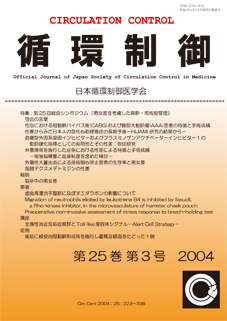All issues

Volume 25 (2004)
- Issue 4 Pages 378-
- Issue 3 Pages 261-
- Issue 2 Pages 158-
- Issue 1 Pages 37-
Volume 25, Issue 3
Displaying 1-4 of 4 articles from this issue
- |<
- <
- 1
- >
- >|
original articles
-
Masayo Takami, Kazuya Urashima, Takako Nishihori, Yoshihiko Hirotani, ...2004Volume 25Issue 3 Pages 261-266
Published: 2004
Released on J-STAGE: December 06, 2004
JOURNAL FREE ACCESSThe effects of edaravone on reperfusion-induced ventricular arrhythmias in the isolated perfused rat heart were investigated. Using Langendorff perfusion-system, each isolated rat heart was perfused with Krebs-Henseleit buffer, containing various concentrations of edaravone(0, 10, 25, 50, 75, 100, 150μM) for 10 minutes. After that, each heart was subjected to regional ischemia(11min) and reperfusion(3min). The result showed that edaravone had no significant effect on coronary flow and heart rate at any time during the experiment. At 25, 75, 100μM of edaravone, the incidence of reperfusion-induced ventricular fibrillation(VF) was significantly reduced from the control value(p<0.05). At 25μM of edaravone, the incidence of sustained VF was significantly reduced from 92% to 50%(p<0.05).
Edaravone is suggested to have a protective effect against reperfusion-induced arrhythmias.View full abstractDownload PDF (277K) -
Akiko Ozawa, Yoshihiro Nara, Hiroshi Kimotsuki, Eri Nakahara, Hirotsug ...2004Volume 25Issue 3 Pages 267-271
Published: 2004
Released on J-STAGE: December 06, 2004
JOURNAL FREE ACCESSThis study was designed to investigate possible effects of a Rho-kinase inhibitor, fasudil, on migration of neutrophils induced by leukotriene B4. The neutrophil behavior was observed in the microvasculature of hamster cheek pouch using a trans-illumination microscope. Superfusion of lekotrience B4 caused an increase in the number of neutrophils adhering the endothelium and migrating through the endothelium outside the venules. The migration induced by lekotrience B4 was significantly attenuated in hamsters receiving intravenous infusion of 10 and 30mg/kg of fasudil prior to the leukotriene B4 superfusion. These results suggest that inhibition of Rho-kinase by fasudil produces an inhibition of neutrophil migration and represents a new therapeutic strategy for neutrophil-mediated tissue damage.View full abstractDownload PDF (621K) -
Ken Yamaura, Sumio Hoka, Junichi Yoshimura, Shosuke Takahashi2004Volume 25Issue 3 Pages 272-275
Published: 2004
Released on J-STAGE: December 06, 2004
JOURNAL FREE ACCESSThe purpose of this study was to evaluate circulatory and respiratory responses to a breath-holding stress test in surgical patients at the bed-side using continuous and non-invasive monitoring with arterial tonometry and pulse oxymetry. Sixty-one patients were assigned into four groups: normal healthy patients(Cont), elderly patients(Elder), hypertensive patients(HT) and diabetic patients(DM). The breath-holding stress test was conducted in the supine position at the functional residual capacity level and in room air. Breath-holding time, changes in heart rate(HR), mean arterial pressure(MAP), arterial oxyhemoglobin saturation using a pulse oxymeter(SpO2) and the recovery time of SpO2 were measured. Breath-holding time was significantly shorter in the HT group(30±2.0sec, p<0.05) and tended to be shorter in the Elder group(31±3.0sec, p=0.08) compared with the Cont group(41±2.9sec). The maximum mean arterial blood pressure(Max-MAP) was higher in the Elder(105±4.0mmHg)(p<0.05) and HT(128±5.6mmHg)(p<0.05) groups compared with the Cont group(93±4.0mmHg). However, ΔMAP, ΔHR, Min-SpO2, and ΔSpO2 were not significantly different among the four groups. Our results suggest that non-invasive continuous monitoring facilitates evaluation of stress responses to breath-holding in preoperative patients, and that the breath-holding stress test causes sympathetic augmentation, resulting in increases in MAP and HR by approximately 15%, concomitant with a decrease in SpO2 to 90-94%. The magnitude of the response is similar regardless of age and existence of HT and DM.View full abstractDownload PDF (143K)
case reports
-
Hiroshi SUMIDA, Kumi NAKAMURA, Atsunari KINO, Takuhiko WAKAMATSU, Rie ...2004Volume 25Issue 3 Pages 285-288
Published: 2004
Released on J-STAGE: December 06, 2004
JOURNAL FREE ACCESSPreoperative application of coronary angiography or percutaneous coronary intervention(PCI) is controversial in Japan. We report a case in which PCI, performed before minor surgery, led to acute myocardial infarction. An 83-year-old woman was scheduled for transurethral resection of a bladder tumor under spinal anesthesia. Her condition was complicated by type 1 diabetes mellitus, and she had a history of myocardial infarctions 21 years and 9 years previously. The ischemic symptoms had not exhibited since the last myocardial infarction under suitable medical treatment. Preoperative coronary angiography was performed, and revealed three-vessel disease. One month later, PCI was performed, but acute myocardial infarction occurred during the procedure, followed by cardiac collapse. The patient was resuscitated without neurological consequences, but was hospitalized for another 187 days. The planned surgery was canceled. This case lets us consider the adoption of ACC/ACH guidelines, in which PCI is not recommended before minor surgery on patients lacking major clinical predictors of increased cardiovascular risk. Otherwise, we have to establish another set of guidelines based on evidence applicable to the Japanese population.View full abstractDownload PDF (574K)
- |<
- <
- 1
- >
- >|